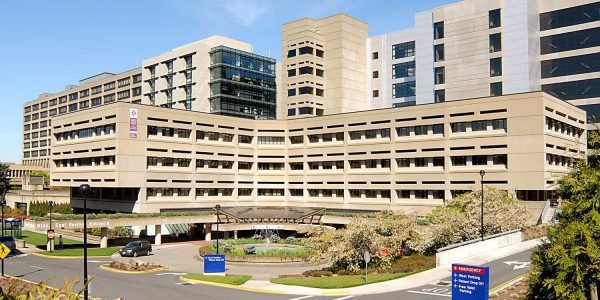Urologic Oncology
Exceptional Service & Treatment for Urologic Oncology
Urologic oncology focuses on treating cancers of the male and female urinary tract and the male reproductive organs.
Northwest Urology, LLC provides expert care for urologic oncology conditions. These include:
Prostate Cancer
Prostate cancer is the second leading cause of cancer deaths among men in the United States, but it can be successfully managed when detected in its early stages. Assessing the stage (extent) of the cancer is critical to an effective treatment plan. Early prostate cancer generally has no symptoms and is discovered through clinical screening consisting of digital rectal exam and a blood test (PSA). When this screening suggests prostate cancer, additional steps are taken to determine if prostate tumors are present and if the cancer has spread to other parts of the body.
The four standard options for treating prostate cancer include: 1) active surveillance, 2) surgery, 3) radiation therapy, and 4) hormone therapy.
Active Surveillance
Because prostate cancer often progresses slowly, for certain patients the best treatment may be to simply monitor the cancer. This does not mean ignoring the condition, but rather developing and implementing a plan of measuring the progression of disease over time. Schedules for imaging, examination and testing are established so that patients with cancers growing more quickly or causing symptoms can be treated effectively without losing the opportunity to cure.
Surgical Intervention
Technological advances have dramatically changed the surgical treatment of prostate cancer. Radical prostatectomy, which involves removing the entire prostate gland, the seminal vesicles and often the surrounding lymph nodes, is no longer the only surgical option. The advent of laparoscopy and robot-assisted laparoscopy offers a minimally invasive procedure that allows more precise treatment while significantly reducing pain, shortening the hospital stay, and minimizing complications.
Northwest Urology, LLC is a leader in the use of the daVinci Robot for minimally invasive urologic surgeries. Several small incisions allow cameras and instruments to be placed inside the abdomen which are controlled by the surgeon using 3-dimensional magnified images. The enhanced vision and dexterity of the robotic instruments enable our surgeons to effectively remove the prostate while sparing the surrounding nerves and minimizing blood loss.
Radiation Therapy
External beam radiation therapy (EBRT) is an established treatment option for certain patients.
Brachytherapy is a method of radiation therapy in which radioactive seeds are distributed throughout the prostate. The seeds remain in the prostate and emit their radiation over time.
Hormone Therapy
Prostate cancer that has spread beyond the prostate gland or metastasized to other organs can have its progression slowed by hormone therapy. Androgen Deprivation Therapy (ADT) impedes prostate cancer cells that are hormone dependent, but only affects cells that require testosterone (which promotes prostate cancer growth and progression). Hormone therapy is used in conjunction with radiation therapy in select cases.
Cryotherapy
Cryotherapy involves freezing the prostate cancer cells while leaving the surrounding tissue unaffected. It is performed under anesthetic and takes approximately 2 hours to complete. Patients typically leave the hospital after the procedure or the next day. Cryotherapy for prostate cancers that have been unsuccessfully treated with radiation is an established use of this technology. As a primary treatment for prostate cancer, cryotherapy is a new treatment option. NW Urology is one of the few medical centers utilizing and evaluating cryotherapy for prostate cancer.
Kidney Cancer
One of the 10 most common cancers, kidney cancer affects more men than women. Kidney cancers are often detected when the patient undergoes an imaging study (CT scan, MRI, etc.) for symptoms unrelated to kidney disease. In its earliest stages, kidney cancer does not cause any symptoms. Symptoms that are found in later stages include blood in the urine, lower back pain, fatigue, loss of appetite, unexplained weight loss, unexplained persistent fever, and swelling of the legs and ankles. These symptoms are not specific to kidney cancer and require evaluation by a physician.
Imaging studies are the main way of diagnosing kidney cancers. CT scan, MRI, ultrasonography, angiography and a renal scan may be performed to determine the presence of a kidney tumor. For kidney cancers in the lining of the urinary transport system (renal pelvis, ureter), a ureteroscope is used to inspect the lining of the kidneys and ureters and to perform a biopsy of any tumors. In addition, the cells of the urine are inspected for abnormality.
Surgery is generally the primary treatment for kidney cancer. Even when the cancer has spread to other parts of the body, removing the primary tumor in the kidney provides information that guides subsequent treatment protocols. Surgical treatments range from total removal of the kidney to freezing or removing just the cancerous tissue. Common surgical treatments for kidney cancer include:
- Kidney Sparing Surgery (Partial Nephrectomy)
Preserving the normal part of the kidney has been shown to decrease the onset of future medical illness. Therefore, UC urologists perform normal kidney sparing procedures whenever possible. The malignant tumor is removed either through open or robot-assisted laparoscopic surgery, or destroyed by laparoscopic or CT-guided percutaneous cryoablation. Patients with only one functioning kidney or those who are at risk for kidney failure require kidney sparing surgery if possible.
- Cryoablation
Northwest Urology, LLC offers computed tomography (CT) guided percutaneous cryoablation, an innovative treatment option for patients with small tumors. Using imaging technology, a small probe is inserted through the skin into the kidney tumor. Additional cryo (freezing) needles are inserted and the cancer tissue is frozen while sparing the areas surrounding the tumor. Because minimally invasive cryoablation spares patients open surgery, it is especially useful for patients who may be too frail to tolerate major surgery. Most patients who undergo CT-guided cryoablation go home the next day.
- Nephrectomy
When removal of the entire kidney is necessary, Northwest Urology, urologists often utilize minimally invasive surgical techniques to speed the patient recovery time and decrease post-operative discomfort. Laparoscopic surgery, robot-assisted laparoscopic surgery and hand-assisted laparoscopic surgery are options available to many patients.
Bladder Cancer
There are 55,000 new cases and 12,000 thousand deaths attributed to bladder cancer in the United States each year. The average age of diagnosis for bladder cancer is 66, with males being diagnosed two times more frequently than females. The most common sign of bladder cancer is blood in the urine, but a small number of patients also experience urinary urgency, frequency, or pain when urinating. While blood in the urine does not necessarily signify bladder cancer, it does require immediate evaluation by a urologist to determine the underlying cause.
The diagnosis of bladder cancer begins with a thorough history and physical examination followed by a CT urogram (x-ray image of the urinary tract). Additionally, a cystoscope is used to inspect the lining of the bladder and take a biopsy (tissue sample) of any lesions. Finally, a test for abnormal cells in the urine (urine cytology) is performed to confirm the diagnosis of bladder cancer.
The most common category of bladder cancer is low stage and low grade disease. This means the cancer is confined to the bladder and is less aggressive. Treatment for this type of bladder cancer is to remove the tumor using a minimally invasive technique.
Bladder cancer that is more pervasive and/or high grade requires more extensive surgical intervention followed by chemotherapy and/or radiation
Testicular Cancer
Although it is rare, testicular cancer is the most common form of cancer in men aged 15 to 35. Fortunately, it is highly responsive to treatments. The earlier the cancer is detected and treated, the better the outcome. Approximately 97% of all testis cancers are cured by surgery alone or with the addition of radiation treatment or chemotherapy when necessary.
Pain and/or a nodule (lump) in the testicle or scrotum are indications that a urologist should be consulted. Any enlargement of a testicle or a sensation of heaviness and swelling also warrant a urologic evaluation. Many conditions other than cancer can cause these symptoms, but it is important that an evaluation be conducted to rule out cancer.
A thorough physical exam and additional tests are necessary to diagnose testicular cancer. The physician will feel for swelling, tenderness and/or nodules. A scrotal ultrasound provides more detailed information of any abnormality. Blood tests are used to diagnose different types of testicular tumors based on the proteins that some testicular cancers produce.
When testicular cancer is diagnosed, surgery to remove the testicle is the preferred treatment for most types and stages of the disease. The testicle is removed through an incision in the groin. In cases where the cancer is discovered in its early stage, surgery may be the only treatment required. In other cases, additional surgery to remove lymph nodes may be necessary. Radiation or chemotherapy may be necessary for patients with advanced stages of testicular cancer.
Adrenal Cancer
The adrenals are small glands situated above each kidney. These endocrine glands secrete hormones that regulate several important physiologic functions throughout the body including kidney function, blood pressure and metabolism.
Most adrenal tumors are benign (not cancerous). Some benign tumors (also known as adenomas) actively secrete hormones in excess causing imbalance of the endocrine system that may lead to high blood pressure, vasoconstriction, fatigue and weight gain. Non-functioning adrenal adenomas typically have no symptoms and are discovered during imaging studies performed for other conditions. Adrenal cancers are rare, but cancers originating in other organs may spread to the adrenal glands.
The preferred treatment for adrenal tumors is surgical removal. Laparoscopic adrenalectomy involves removing the entire adrenal and surrounding tissue. This treatment is typically used for benign adrenal tumors larger than 5 cm or small tumors that may be malignant or are producing high levels of hormones.
Currently, open surgery is only performed when the adrenal tumors are larger than 10 cm or when cancer is suspected and it appears to have spread to other neighboring organs.
Locations

NW Portland (Suite 210)
-
2230 NW Pettygrove Street, Suite 210
Portland, OR 97210 - (503) 223-6223
- (503) 223-3665

NW Portland (Suite 160)
-
2226 NW Pettygrove, Ste. 160
Portland, OR 97210 - (503) 223-6223
- (503) 546-7228

SW Portland / St. Vincent Hospital
-
9135 SW Barnes Rd #663
Portland, OR 97225 - (503) 297-1078
- (503) 292-2176

